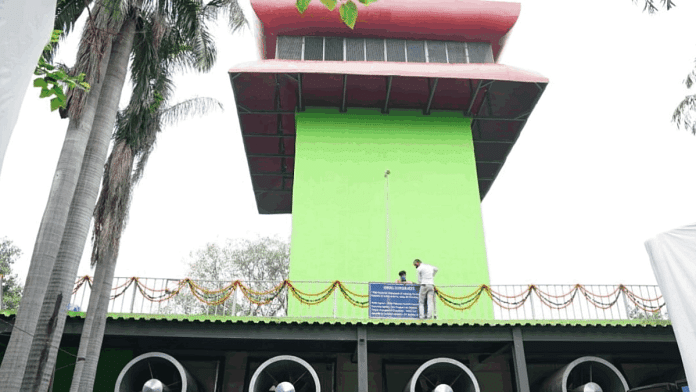New Delhi: The two-year pilot project to create a clean air zone in Delhi, with a smog tower in Delhi’s Connaught Place (CP), has not made a marked improvement in the air quality and is effective only within a short radius, ThePrint has learnt.
A smog tower is essentially a large-scale air purifier. Following a Supreme Court order in September 2020, the Delhi government installed a smog tower in CP in August 2021, the first in India. The Centre then installed a similar one in Anand Vihar later that year.
Over the past two years, a team of researchers from IIT-Bombay and IIT-Delhi studied the efficiency of these smog towers in providing clean air zones in specific regions and their performance in reducing the levels of chief pollutants, PM2.5 and PM10.
Their final reports will soon be submitted — the CP smog tower report to the Delhi Pollution Control Committee and the one for the Anand Vihar smog tower to the Central Pollution Control Board (CPCB).
Sources in the Delhi government familiar with the findings of the study of the CP smog tower told ThePrint that the 24 metre-high structure improves the air quality only by 10-15 percent and that too only within a 500-metre radius.
ThePrint reached Delhi Environment Minister Gopal Rai for comment but had not received a response by the time of publication. This report will be updated if and when a response is received.
The smog tower in CP was installed at a cost of Rs 20 crore, and comprises 40 fans that push air through 4 metre-high filtration systems which cover the four sides of the structure with a total airflow rate of 960 cubic meter per second (m3/second), according to details mentioned in the apex court’s 2020 order, which ThePrint has seen. Further, the order noted that the effective clean air delivery rate of the structure stood at 75 million m3/day.
“It was reported that on an average, 65 percent of (pollution) reduction can be achieved up to 700 m and it is expected to influence more than 1 km in the downwind direction. At the same time, the radius of influence is around 400 m in all other directions,” it noted.
A source in the Delhi government pointed out that as far as the objective is concerned, the smog tower creates a good quality air zone, albeit only within a small radius.
“However, Rs 20 crore for improving air quality within a 500-metre radius is a waste of money, and going by this logic, land for setting such towers will be unavailable. Smog towers are not a viable solution,” said the source.
The source also said that a more effective approach would be to mitigate the pollutants at source, adding that dust generated from roads, construction, demolition sites and vehicles must be curbed. “Once generated, it is very difficult to do anything after, they end up playing with the weather gods (polluting the environment).”
Commenting on the efficiency of the smog tower, Karthik Ganesan, fellow and director (research coordination) at the Council on Energy, Environment and Water (CEEW), a New Delhi-headquartered non-profit policy research institution, said it is pointless to think that one can clean the air by vacuuming it.
A smog tower is effectively trying to suck pollution out of a never-ending expanse of air, he explained.
“Road dust owes its (significant) origin to poor management of earth waste that is moved at the time of construction and demolitions. While there is wind-blown sand from the nearby Thar desert, there is much to be done with construction and demolition waste management and enforcing best practices on industry. Despite the overhang of suspension in construction activity in the peak period, there has been little move to institutionalise good practices by the industry groups,” Ganesan told The Print.
Also read: Action plans, anti-smog guns, war room – Delhi announces blueprint to combat winter pollution
MCD’s mechanised cleaning shortfall
The Delhi government has implemented a slew of other measures to mitigate the pollutants at source, including water sprinklers, anti-smog guns and mechanical road sweeping machines. But Delhi government data shows that these measures have also fallen short.
Roads in Delhi are maintained by different agencies, including the New Delhi Municipal Council (NDMC), the National Highways Authority of India (NHAI), the Central Public Works Department (CPWD), and the National Capital Region Transport Corporation (NCRTC).
Of the 7,963.29 km of Delhi’s road length identified for mechanised cleaning per day, the cleaning of 6,731 km falls under the jurisdiction of the Municipal Corporation of Delhi (MCD).
Government data accessed by ThePrint shows that of these 7,963.29 km, the average length cleaned by various agencies per day in August this year was only 2,694.3 km — a daily shortfall of 5,268.99 km. This means that only 33.83 percent of the entire road length was cleaned on average each day in August. According to the official data, the MCD has 52 mechanised road sweeping machines, while the NDMC has three.
ThePrint reached Amit Kumar, director of MCD’s press & information department, for comment, but had not received a response by the time of publication. This report will be updated if and when a response is received.
(Edited by Smriti Sinha)
Also read: In absence of new framework, Delhi’s old excise policy extended for another six months



